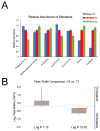Two complementary reversed-phase separations for comprehensive coverage of the semipolar and nonpolar metabolome
- PMID: 29256075
- PMCID: PMC5776055
- DOI: 10.1007/s00216-017-0768-x
Two complementary reversed-phase separations for comprehensive coverage of the semipolar and nonpolar metabolome
Abstract
Although it is common in untargeted metabolomics to apply reversed-phase liquid chromatography (RPLC) and hydrophilic interaction liquid chromatography (HILIC) methods that have been systematically optimized for lipids and central carbon metabolites, here we show that these established protocols provide poor coverage of semipolar metabolites because of inadequate retention. Our objective was to develop an RPLC approach that improved detection of these metabolites without sacrificing lipid coverage. We initially evaluated columns recently released by Waters under the CORTECS line by analyzing 47 small-molecule standards that evenly span the nonpolar and semipolar ranges. An RPLC method commonly used in untargeted metabolomics was considered a benchmarking reference. We found that highly nonpolar and semipolar metabolites cannot be reliably profiled with any single method because of retention and solubility limitations of the injection solvent. Instead, we optimized a multiplexed approach using the CORTECS T3 column to analyze semipolar compounds and the CORTECS C8 column to analyze lipids. Strikingly, we determined that combining these methods allowed detection of 41 of the total 47 standards, whereas our reference RPLC method detected only 10 of the 47 standards. We then applied credentialing to compare method performance at the comprehensive scale. The tandem method showed more than a fivefold increase in credentialing coverage relative to our RPLC benchmark. Our results demonstrate that comprehensive coverage of metabolites amenable to reversed-phase separation necessitates two reconstitution solvents and chromatographic methods. Thus, we suggest complementing HILIC methods with a dual T3 and C8 RPLC approach to increase coverage of semipolar metabolites and lipids for untargeted metabolomics. Graphical abstract Analysis of semipolar and nonpolar metabolites necessitates two reversed-phase chromatography (RPLC) methods, which extend metabolome coverage more than fivefold for untargeted profiling. HILIC hydrophilic interaction liquid chromatography.
Keywords: Global coverage; Mass spectrometry; Metabolomics; Reversed-phase; Semipolar metabolome; Untargeted profiling.
Conflict of interest statement
G.J.P. is a scientific advisory board member for Cambridge Isotope Laboratories and a recipient of the Agilent Early Career Professor Award. No other authors have competing financial interests. The authors declare no nonfinancial conflicts of interest.
Figures




Similar articles
-
Alternate reversed-phase and hydrophilic interaction liquid chromatography coupled with mass spectrometry for broad coverage in metabolomics analysis.J Chromatogr B Analyt Technol Biomed Life Sci. 2020 Sep 1;1152:122266. doi: 10.1016/j.jchromb.2020.122266. Epub 2020 Jul 14. J Chromatogr B Analyt Technol Biomed Life Sci. 2020. PMID: 32693368
-
Optimized Analytical Procedures for the Untargeted Metabolomic Profiling of Human Urine and Plasma by Combining Hydrophilic Interaction (HILIC) and Reverse-Phase Liquid Chromatography (RPLC)-Mass Spectrometry.Mol Cell Proteomics. 2015 Jun;14(6):1684-95. doi: 10.1074/mcp.M114.046508. Epub 2015 Mar 18. Mol Cell Proteomics. 2015. PMID: 25787789 Free PMC article.
-
Comparison of underivatized silica and zwitterionic sulfobetaine hydrophilic interaction liquid chromatography stationary phases for global metabolomics of human plasma.J Chromatogr A. 2019 Dec 20;1608:460419. doi: 10.1016/j.chroma.2019.460419. Epub 2019 Aug 8. J Chromatogr A. 2019. PMID: 31439439
-
HILIC-MS for metabolomics: An attractive and complementary approach to RPLC-MS.Mass Spectrom Rev. 2016 Sep;35(5):574-600. doi: 10.1002/mas.21445. Epub 2014 Oct 3. Mass Spectrom Rev. 2016. PMID: 25284160 Review.
-
Hydrophilic interaction chromatography coupled to MS for metabonomic/metabolomic studies.J Sep Sci. 2010 Mar;33(6-7):716-27. doi: 10.1002/jssc.200900803. J Sep Sci. 2010. PMID: 20187037 Review.
Cited by
-
Chemical Discovery in the Era of Metabolomics.J Am Chem Soc. 2020 May 20;142(20):9097-9105. doi: 10.1021/jacs.9b13198. Epub 2020 May 11. J Am Chem Soc. 2020. PMID: 32275430 Free PMC article. Review.
-
A Protocol for Untargeted Metabolomic Analysis: From Sample Preparation to Data Processing.Methods Mol Biol. 2021;2276:357-382. doi: 10.1007/978-1-0716-1266-8_27. Methods Mol Biol. 2021. PMID: 34060055 Free PMC article.
-
Multi-Omics Investigation into Acute Myocardial Infarction: An Integrative Method Revealing Interconnections amongst the Metabolome, Lipidome, Glycome, and Metallome.Metabolites. 2022 Nov 8;12(11):1080. doi: 10.3390/metabo12111080. Metabolites. 2022. PMID: 36355163 Free PMC article.
-
Nicotinamide mononucleotide increases muscle insulin sensitivity in prediabetic women.Science. 2021 Jun 11;372(6547):1224-1229. doi: 10.1126/science.abe9985. Epub 2021 Apr 22. Science. 2021. PMID: 33888596 Free PMC article. Clinical Trial.
-
A Protocol to Compare Methods for Untargeted Metabolomics.Methods Mol Biol. 2019;1862:1-15. doi: 10.1007/978-1-4939-8769-6_1. Methods Mol Biol. 2019. PMID: 30315456 Free PMC article.
References
-
- Haggarty J, Burgess KEV. Recent advances in liquid and gas chromatography methodology for extending coverage of the metabolome. Curr Opin Biotechnol. 2017;43:77–85. doi: http://dx.doi.org/10.1016/j.copbio.2016.09.006. - DOI - PubMed
-
- Psychogios N, Hau DD, Peng J, Guo AC, Mandal R, Bouatra S, Sinelnikov I, Krishnamurthy R, Eisner R, Gautam B, Young N, Xia J, Knox C, Dong E, Huang P, Hollander Z, Pedersen TL, Smith SR, Bamforth F, Greiner R, McManus B, Newman JW, Goodfriend T, Wishart DS. The Human Serum Metabolome. PLoS One. 2011;6:e16957. https://doi.org/10.1371/journal.pone.0016957. - DOI - PMC - PubMed
MeSH terms
Grants and funding
LinkOut - more resources
Full Text Sources
Other Literature Sources

